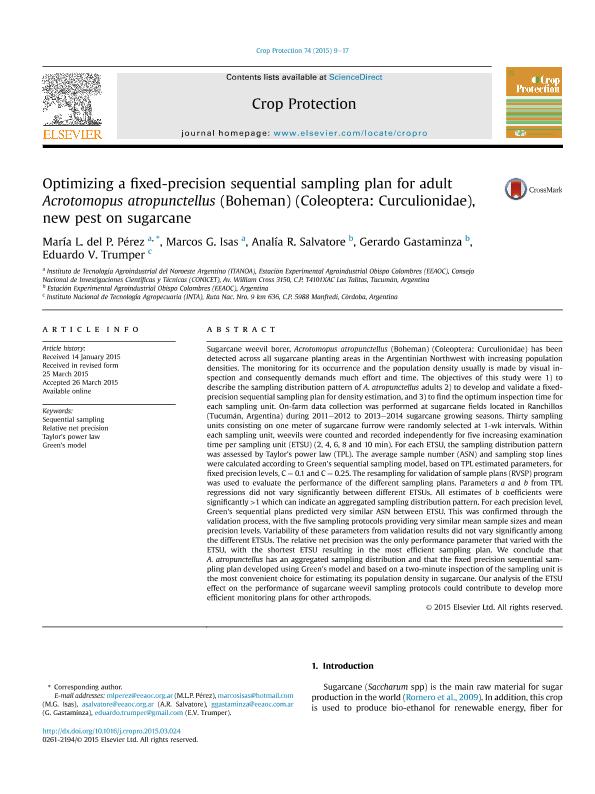Mostrar el registro sencillo del ítem
dc.contributor.author
Perez, Maria Lucia del Pilar

dc.contributor.author
Isas, Marcos Gerardo

dc.contributor.author
Salvatore, Analia R.
dc.contributor.author
Gastaminza, Gerardo
dc.contributor.author
Trumper, Eduardo V.
dc.date.available
2017-03-31T20:03:02Z
dc.date.issued
2015-08
dc.identifier.citation
Perez, Maria Lucia del Pilar; Isas, Marcos Gerardo; Salvatore, Analia R.; Gastaminza, Gerardo; Trumper, Eduardo V.; Optimizing a fixed-precision sequential sampling plan for adult Acrotomopus atropunctellus (Boheman) (Coleoptera: Curculionidae), new pest on sugarcane; Elsevier; Crop Protection; 74; 8-2015; 9-17
dc.identifier.issn
0261-2194
dc.identifier.uri
http://hdl.handle.net/11336/14636
dc.description.abstract
Sugarcane weevil borer, Acrotomopus atropunctellus (Boheman) (Coleoptera: Curculionidae) has been detected across all sugarcane planting areas in the Argentinian Northwest with increasing population densities. The monitoring for its occurrence and the population density usually is made by visual inspection and consequently demands much effort and time. The objectives of this study were 1) to describe the sampling distribution pattern of A. atropunctellus adults 2) to develop and validate a fixed-precision sequential sampling plan for density estimation, and 3) to find the optimum inspection time for each sampling unit. On-farm data collection was performed at sugarcane fields located in Ranchillos (Tucumán, Argentina) during 2011–2012 to 2013–2014 sugarcane growing seasons. Thirty sampling units consisting on one meter of sugarcane furrow were randomly selected at 1-wk intervals. Within each sampling unit, weevils were counted and recorded independently for five increasing examination time per sampling unit (ETSU) (2, 4, 6, 8 and 10 min). For each ETSU, the sampling distribution pattern was assessed by Taylor's power law (TPL). The average sample number (ASN) and sampling stop lines were calculated according to Green's sequential sampling model, based on TPL estimated parameters, for fixed precision levels, C = 0.1 and C = 0.25. The resampling for validation of sample plans (RVSP) program was used to evaluate the performance of the different sampling plans. Parameters a and b from TPL regressions did not vary significantly between different ETSUs. All estimates of b coefficients were significantly >1 which can indicate an aggregated sampling distribution pattern. For each precision level, Green's sequential plans predicted very similar ASN between ETSU. This was confirmed through the validation process, with the five sampling protocols providing very similar mean sample sizes and mean precision levels. Variability of these parameters from validation results did not vary significantly among the different ETSUs. The relative net precision was the only performance parameter that varied with the ETSU, with the shortest ETSU resulting in the most efficient sampling plan. We conclude that A. atropunctellus has an aggregated sampling distribution and that the fixed precision sequential sampling plan developed using Green's model and based on a two-minute inspection of the sampling unit is the most convenient choice for estimating its population density in sugarcane. Our analysis of the ETSU effect on the performance of sugarcane weevil sampling protocols could contribute to develop more efficient monitoring plans for other arthropods.
dc.format
application/pdf
dc.language.iso
eng
dc.publisher
Elsevier

dc.rights
info:eu-repo/semantics/openAccess
dc.rights.uri
https://creativecommons.org/licenses/by-nc-nd/2.5/ar/
dc.subject
Sequential Sampling
dc.subject
Relative Net Precision
dc.subject
Taylors Power Law
dc.subject
Greens Model
dc.subject.classification
Agricultura

dc.subject.classification
Agricultura, Silvicultura y Pesca

dc.subject.classification
CIENCIAS AGRÍCOLAS

dc.title
Optimizing a fixed-precision sequential sampling plan for adult Acrotomopus atropunctellus (Boheman) (Coleoptera: Curculionidae), new pest on sugarcane
dc.type
info:eu-repo/semantics/article
dc.type
info:ar-repo/semantics/artículo
dc.type
info:eu-repo/semantics/publishedVersion
dc.date.updated
2017-03-31T19:20:50Z
dc.journal.volume
74
dc.journal.pagination
9-17
dc.journal.pais
Países Bajos

dc.journal.ciudad
Amsterdam
dc.description.fil
Fil: Perez, Maria Lucia del Pilar. Consejo Nacional de Investigaciones Científicas y Técnicas. Centro Científico Tecnológico Tucumán. Instituto de Tecnología Agroindustrial del Noroeste Argentino; Argentina; Argentina. Gobierno de Tucumán. Ministerio de Desarrollo Productivo. Estación Experimental Agroindustrial Obispo Colombres; Argentina
dc.description.fil
Fil: Isas, Marcos Gerardo. Consejo Nacional de Investigaciones Científicas y Técnicas. Centro Científico Tecnológico Tucumán. Instituto de Tecnología Agroindustrial del Noroeste Argentino; Argentina; Argentina. Gobierno de Tucumán. Ministerio de Desarrollo Productivo. Estación Experimental Agroindustrial Obispo Colombres; Argentina
dc.description.fil
Fil: Salvatore, Analia R.. Gobierno de Tucumán. Ministerio de Desarrollo Productivo. Estación Experimental Agroindustrial Obispo Colombres; Argentina
dc.description.fil
Fil: Gastaminza, Gerardo. Gobierno de Tucumán. Ministerio de Desarrollo Productivo. Estación Experimental Agroindustrial Obispo Colombres; Argentina
dc.description.fil
Fil: Trumper, Eduardo V.. Instituto Nacional de Tecnología Agropecuaria; Argentina
dc.journal.title
Crop Protection

dc.relation.alternativeid
info:eu-repo/semantics/altIdentifier/doi/http://dx.doi.org/10.1016/j.cropro.2015.03.024
dc.relation.alternativeid
info:eu-repo/semantics/altIdentifier/url/http://www.sciencedirect.com/science/article/pii/S0261219415001076
Archivos asociados
